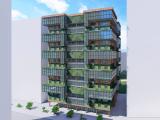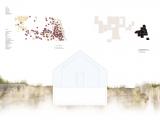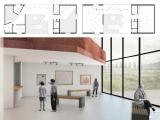DSGN 410 / Fall 2020
PROJECT DESCRIPTION:
As stewards of the built and natural environment, it is our responsibility to design for all: regardless of race, gender, sexuality, financial status, or ability. The Green New Deal serves as a legislative reminder of the systemic injustices, exacerbated by climate change, which disproportionately affect frontline and vulnerable communities.
Holding the title of “world’s largest stockyard” from 1955 to 1971, South Omaha’s agricultural and industrial heritage once positioned the community as an economic powerhouse. Since the Stockyards’ decline and eventual closure at the turn of the millenium, the site has underperformed as a first generation suburban core.
The Stockyards district is sited southwest of a major highway junction. Coupled with substantial railways and heavy industrial zoning, this infrastructural corridor segregates South Omaha from the rest of the city. Despite territorial setbacks, the community has a rich cultural identity due to its current and historical status as a destination for immigrants, a reputation largely attributed to the presence of the food processing industry.
We aim to invert the Stockyards site from one which historically fostered industrial productivity to one which facilitates socio-cultural productivity through the introduction of a Social Condenser typology. The project will promote collaboration, variability, and resiliency within the South Omaha community through programs which provide access to nutrient rich food, affordable space to operate small businesses, area to safely hold formal and informal gatherings, access to academic assistance and enrichment, opportunity to create and share art, engaging historical and cultural education, and access to a quality outdoor environment.
STUDIO DESCRIPTION:
POST- STUDIO is a multidisciplinary collaborative studio between architecture and landscape architecture students exploring the relationship between land, justice, climate change, and policy. Post-Carbon, Post-Oil, Post-Spatial Disparity, Post-Anthropocene, Post- <insertproblematique>. The notion of "Post-" implies a future state. In this studio, students are asked to speculate on the future of ongoing current issues that are impacting our communities. One of the most significant national conversations surrounding these concerns is the Green New Deal (GND), which considers the state as an activist force to consider issues of global warming, economic inequalities, and systemic racism/sexism.
The GND is a reference to the New Deal (1933-1939), which was a “series of programs, public work projects, financial reforms, and regulations enacted by President Franklin D. Roosevelt in the United States responding to needs for relief, reform, and recovery from the Great Depression.” POST- Studio is a participant in the Landscape Architecture Foundation (LAF) sponsored Green New Deal Superstudio, where academic design studios across the country explored critical themes outlined by the recent Green New Deal climate proposal.
Within this framework, the studio asks, what does it mean to be a design activist? And what is the relationship of architecture and land, and how do we, as stewards of the environment, critically respond to ongoing and contentious political discourse? Geographically, this studio focuses on historically redlined areas of Omaha. Through research and designing, students sought to explore the implications of a variety of salient issues considered as part of the Green New Deal, including lead contamination, food access, job training, and community resilience.
Follow the College of Architecture






